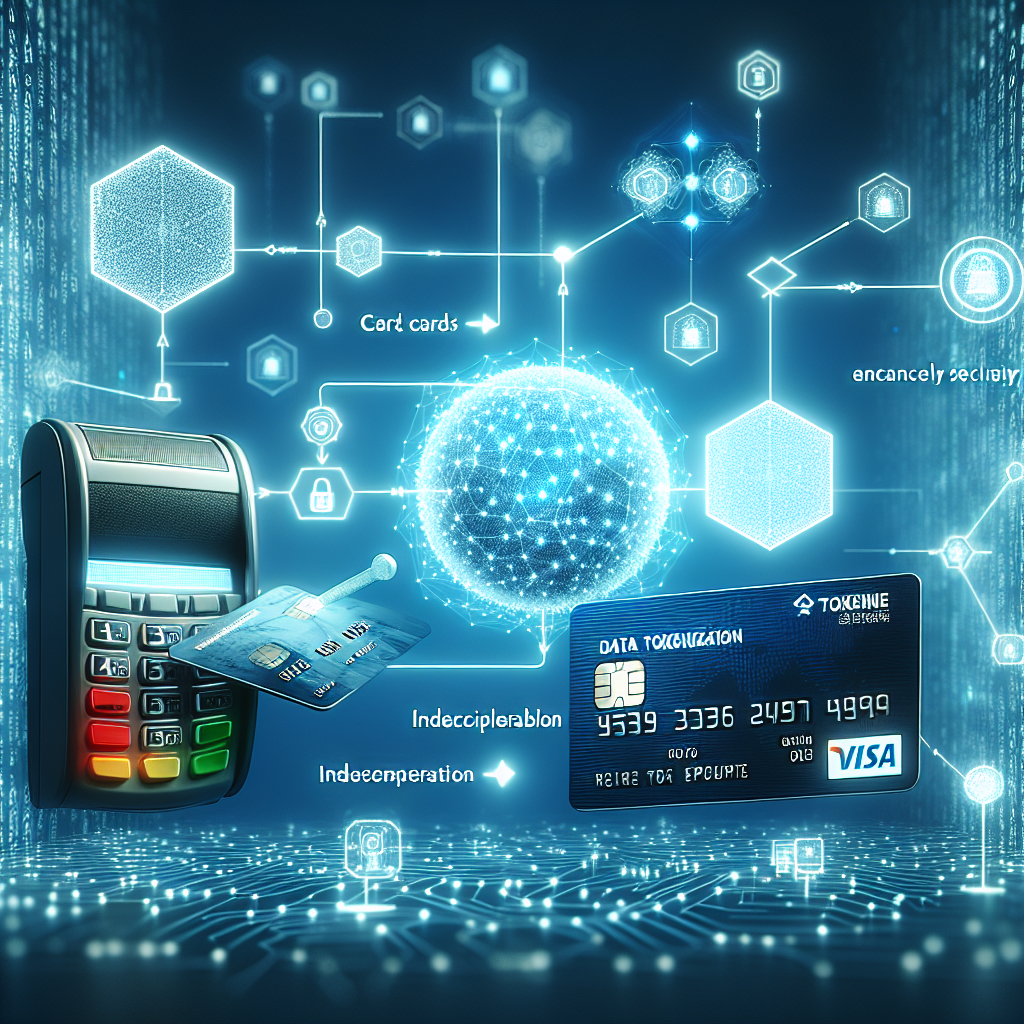-
Table of Contents
- The Importance of Data Tokenization in Payment Transactions
- How Data Tokenization Works to Protect Sensitive Information
- Benefits of Implementing Data Tokenization in Payment Systems
- Common Challenges and Solutions in Data Tokenization for Payment Transactions
- Future Trends and Innovations in Data Tokenization for Enhanced Security
- Q&A
The Importance of Data Tokenization in Payment Transactions
Data Tokenization: Enhancing Security in Payment Transactions
In today’s digital age, where online transactions have become the norm, ensuring the security of payment transactions has become a top priority for businesses and consumers alike. With the increasing number of data breaches and cyber-attacks, it is crucial to adopt robust security measures to protect sensitive information. One such measure that has gained significant attention is data tokenization.
Data tokenization is a process that replaces sensitive data, such as credit card numbers or social security numbers, with unique identification symbols called tokens. These tokens are randomly generated and have no intrinsic value, making them useless to hackers even if they manage to intercept them. By tokenizing data, businesses can significantly reduce the risk of data breaches and protect their customers’ sensitive information.
The importance of data tokenization in payment transactions cannot be overstated. Traditional methods of securing payment data, such as encryption, have proven to be vulnerable to sophisticated cyber-attacks. Encryption involves converting data into a coded form that can only be accessed with a decryption key. However, if hackers manage to obtain the key, they can easily decrypt the data and gain unauthorized access. In contrast, tokenization eliminates the need for a decryption key, making it a more secure alternative.
Furthermore, data tokenization offers several advantages over other security measures. Firstly, it reduces the scope of compliance requirements for businesses. When sensitive data is tokenized, it falls outside the scope of Payment Card Industry Data Security Standard (PCI DSS) compliance. This means that businesses can significantly reduce the cost and effort required to comply with stringent security regulations.
Secondly, data tokenization simplifies the process of storing and transmitting sensitive information. Instead of storing vast amounts of sensitive data, businesses can store and transmit tokens, which are much smaller in size. This not only reduces storage costs but also improves the efficiency of payment processing systems. Additionally, tokenization eliminates the need for businesses to transmit sensitive data across networks, further reducing the risk of interception by hackers.
Moreover, data tokenization enhances customer trust and confidence in payment transactions. With the increasing number of high-profile data breaches, consumers are becoming more cautious about sharing their sensitive information online. By implementing data tokenization, businesses can assure their customers that their data is secure and protected. This, in turn, can lead to increased customer loyalty and repeat business.
It is worth noting that data tokenization is not a standalone solution for securing payment transactions. It should be implemented as part of a comprehensive security strategy that includes other measures such as firewalls, intrusion detection systems, and regular security audits. However, data tokenization plays a crucial role in enhancing the overall security posture of businesses.
In conclusion, data tokenization is a powerful tool for enhancing security in payment transactions. By replacing sensitive data with tokens, businesses can significantly reduce the risk of data breaches and protect their customers’ sensitive information. The advantages of data tokenization, such as simplified compliance requirements, improved efficiency, and increased customer trust, make it an essential component of any robust security strategy. As the threat landscape continues to evolve, businesses must prioritize data tokenization to stay one step ahead of cybercriminals and safeguard their payment transactions.
How Data Tokenization Works to Protect Sensitive Information
Data Tokenization: Enhancing Security in Payment Transactions
In today’s digital age, where online transactions have become the norm, ensuring the security of sensitive information has become a top priority for businesses and consumers alike. One method that has gained significant attention in recent years is data tokenization. This article will explore how data tokenization works to protect sensitive information in payment transactions.
Data tokenization is a process that replaces sensitive data, such as credit card numbers or social security numbers, with unique identification symbols called tokens. These tokens are randomly generated and have no intrinsic value, making them useless to hackers or unauthorized individuals. The original sensitive data is stored in a secure database, while the tokens are used for transactional purposes.
The process of data tokenization begins with the collection of sensitive information during a payment transaction. Instead of storing this information in its original form, it is immediately encrypted and replaced with a token. This token is then sent to the payment processor or gateway for further processing. The sensitive data is securely stored in a separate database, often referred to as a token vault.
When a transaction needs to be authorized or processed, the token is used instead of the original sensitive data. This token is sent to the token vault, where it is decrypted and matched with the corresponding sensitive information. The transaction is then authorized or declined based on the information retrieved from the token vault. This entire process happens seamlessly and quickly, ensuring a smooth payment experience for the customer.
One of the key advantages of data tokenization is that it significantly reduces the risk of data breaches. Since the sensitive information is never stored or transmitted in its original form, even if a hacker gains access to the tokenized data, they would not be able to decipher it without the corresponding decryption keys. This adds an extra layer of security to payment transactions, giving businesses and consumers peace of mind.
Furthermore, data tokenization also helps businesses comply with industry regulations and standards, such as the Payment Card Industry Data Security Standard (PCI DSS). By tokenizing sensitive data, businesses can minimize their scope of compliance, as the token vault becomes the only system that needs to be audited and secured. This simplifies the compliance process and reduces the associated costs and complexities.
Another benefit of data tokenization is its versatility. It can be applied to various types of sensitive information, not just credit card numbers. For example, businesses can tokenize social security numbers, bank account numbers, or even personal identification numbers (PINs). This flexibility allows businesses to protect a wide range of sensitive data, enhancing overall security in their payment transactions.
In conclusion, data tokenization is a powerful tool for enhancing security in payment transactions. By replacing sensitive data with tokens, businesses can significantly reduce the risk of data breaches and comply with industry regulations. The versatility of data tokenization makes it a valuable asset for protecting various types of sensitive information. As online transactions continue to grow, data tokenization will play a crucial role in safeguarding sensitive data and ensuring secure payment experiences for businesses and consumers alike.
Benefits of Implementing Data Tokenization in Payment Systems

Data Tokenization: Enhancing Security in Payment Transactions
In today’s digital age, where online transactions have become the norm, ensuring the security of payment systems is of utmost importance. With the increasing number of data breaches and cyber threats, businesses need to adopt robust security measures to protect sensitive customer information. One such measure is data tokenization, a process that replaces sensitive data with unique tokens, enhancing security in payment transactions.
Implementing data tokenization in payment systems offers several benefits. Firstly, it reduces the risk of data breaches. By replacing sensitive information such as credit card numbers or social security numbers with tokens, businesses can significantly minimize the chances of unauthorized access to valuable customer data. Even if a hacker manages to breach the system, they would only obtain meaningless tokens instead of actual sensitive information.
Moreover, data tokenization simplifies compliance with industry regulations. Many industries, such as healthcare and finance, have strict regulations regarding the storage and protection of customer data. By implementing data tokenization, businesses can ensure compliance with these regulations, as the sensitive data is no longer stored in its original form. This not only helps avoid hefty fines but also builds trust with customers who value their privacy and expect businesses to handle their data responsibly.
Another benefit of data tokenization is its impact on the overall customer experience. Traditional methods of securing payment transactions often involve lengthy and complex authentication processes, which can be frustrating for customers. With data tokenization, the need for customers to repeatedly enter sensitive information is eliminated. Once the initial token is generated, it can be used for subsequent transactions, making the payment process faster and more convenient. This not only enhances customer satisfaction but also encourages repeat business.
Furthermore, data tokenization enhances the security of payment systems without compromising operational efficiency. Unlike encryption, which requires decryption for authorized access, tokens can be easily processed without the need for decryption. This means that businesses can continue to operate smoothly without sacrificing speed or performance. Additionally, tokenization allows for seamless integration with existing payment systems, minimizing disruption and reducing implementation costs.
Data tokenization also provides an added layer of security for businesses that store customer data. In the event of a data breach, the stolen tokens are essentially useless to hackers without the corresponding decryption keys. This significantly reduces the potential damage and financial loss that businesses may incur as a result of a breach. By implementing data tokenization, businesses can demonstrate their commitment to protecting customer data, which can enhance their reputation and attract more customers.
In conclusion, data tokenization is a powerful tool for enhancing security in payment transactions. Its benefits include reducing the risk of data breaches, simplifying compliance with industry regulations, improving the customer experience, maintaining operational efficiency, and providing an added layer of security for businesses. As the threat landscape continues to evolve, businesses must prioritize the implementation of robust security measures like data tokenization to safeguard sensitive customer information and maintain trust in the digital marketplace.
Common Challenges and Solutions in Data Tokenization for Payment Transactions
Data Tokenization: Enhancing Security in Payment Transactions
Common Challenges and Solutions in Data Tokenization for Payment Transactions
In today’s digital age, where online transactions have become the norm, ensuring the security of payment data has become a top priority for businesses. One effective method that has gained popularity is data tokenization. Data tokenization involves replacing sensitive payment data with a unique identifier, known as a token, which is then used for transaction processing. This article will explore the common challenges faced in implementing data tokenization for payment transactions and the solutions available to overcome them.
One of the primary challenges in data tokenization is the complexity of the implementation process. Businesses often struggle with integrating tokenization into their existing payment systems. This challenge arises due to the need for compatibility between the tokenization solution and the various payment platforms used by businesses. To address this, companies can opt for tokenization solutions that offer seamless integration with multiple payment gateways and processors. This ensures a smooth transition without disrupting the existing payment infrastructure.
Another challenge is the need to maintain data integrity throughout the tokenization process. It is crucial to ensure that the original data and its corresponding token are securely linked. Any discrepancy or loss of this link can lead to transaction failures or errors. To overcome this challenge, businesses can implement robust tokenization solutions that provide strong encryption algorithms and secure key management systems. These measures ensure the integrity of the data-token relationship, minimizing the risk of errors or data breaches.
Data security is a paramount concern in payment transactions, and tokenization helps address this challenge. However, businesses must also consider the security of the tokenization process itself. Unauthorized access to the tokenization system can compromise the security of the payment data. To mitigate this risk, businesses should implement multi-factor authentication and access controls to restrict access to the tokenization infrastructure. Regular security audits and vulnerability assessments can also help identify and address any potential weaknesses in the system.
Maintaining compliance with industry regulations and standards is another challenge in data tokenization for payment transactions. Businesses must ensure that their tokenization solution adheres to the Payment Card Industry Data Security Standard (PCI DSS) and other relevant regulations. This requires implementing robust security measures, such as encryption, secure key management, and regular audits. Additionally, businesses should choose tokenization solutions that offer comprehensive reporting capabilities to facilitate compliance monitoring and reporting.
Scalability is a crucial consideration for businesses, especially those experiencing rapid growth. As transaction volumes increase, the tokenization system must be able to handle the additional load without compromising performance or security. To address this challenge, businesses can opt for tokenization solutions that offer scalable infrastructure and flexible deployment options. Cloud-based tokenization solutions, for example, provide the scalability needed to accommodate growing transaction volumes while ensuring high availability and performance.
In conclusion, data tokenization is an effective method for enhancing security in payment transactions. However, businesses face several challenges in implementing and maintaining a robust tokenization system. By choosing tokenization solutions that offer seamless integration, strong encryption, secure key management, and comprehensive reporting capabilities, businesses can overcome these challenges. Additionally, implementing multi-factor authentication, access controls, and regular security audits can further enhance the security of the tokenization process. With the right solutions and measures in place, businesses can ensure the security and integrity of their payment data, instilling trust and confidence in their customers.
Future Trends and Innovations in Data Tokenization for Enhanced Security
Data Tokenization: Enhancing Security in Payment Transactions
In today’s digital age, where online transactions have become the norm, ensuring the security of sensitive data has become a top priority for businesses and consumers alike. One innovative solution that has emerged to address this concern is data tokenization. This article will explore the future trends and innovations in data tokenization for enhanced security in payment transactions.
Data tokenization is a process that replaces sensitive data, such as credit card numbers or social security numbers, with unique identification symbols called tokens. These tokens are randomly generated and have no intrinsic value, making them useless to hackers or unauthorized individuals. By tokenizing data, businesses can significantly reduce the risk of data breaches and protect their customers’ sensitive information.
One of the future trends in data tokenization is the adoption of cloud-based tokenization services. With the increasing popularity of cloud computing, businesses are looking for ways to leverage its benefits while maintaining data security. Cloud-based tokenization allows businesses to store and manage their tokens in a secure cloud environment, eliminating the need for on-premises infrastructure. This not only reduces costs but also provides scalability and flexibility, making it an attractive option for businesses of all sizes.
Another trend in data tokenization is the integration of tokenization with other security measures, such as encryption and multi-factor authentication. While tokenization provides an additional layer of security, combining it with other security measures can further enhance data protection. Encryption ensures that even if a token is intercepted, it remains unreadable without the encryption key. Multi-factor authentication adds an extra layer of verification, requiring users to provide multiple forms of identification before accessing sensitive data. By integrating these security measures, businesses can create a robust defense against data breaches.
Innovations in data tokenization are also focused on improving the user experience. Traditionally, tokenization required businesses to store a mapping table that linked tokens to their corresponding sensitive data. However, this approach posed a risk if the mapping table was compromised. To address this concern, new tokenization techniques are being developed that eliminate the need for a mapping table. These techniques use algorithms to generate tokens based on specific data attributes, ensuring that the same data always generates the same token. This not only enhances security but also simplifies tokenization implementation for businesses.
Furthermore, advancements in machine learning and artificial intelligence are being leveraged to enhance data tokenization. These technologies can analyze patterns and detect anomalies in data, helping businesses identify potential security threats. By continuously monitoring and analyzing data, machine learning algorithms can adapt and improve tokenization techniques, making them more effective in preventing data breaches.
As the world becomes increasingly interconnected, the need for secure payment transactions is paramount. Data tokenization offers a promising solution to this challenge, providing businesses with a robust and scalable security measure. The future trends and innovations in data tokenization, such as cloud-based services, integration with other security measures, improved user experience, and leveraging machine learning, will further enhance the security of payment transactions.
In conclusion, data tokenization is revolutionizing the way businesses protect sensitive data in payment transactions. By replacing sensitive information with tokens, businesses can significantly reduce the risk of data breaches. The future trends and innovations in data tokenization, such as cloud-based services, integration with other security measures, improved user experience, and leveraging machine learning, will continue to enhance the security of payment transactions. As technology evolves, it is crucial for businesses to stay updated with these advancements to ensure the safety of their customers’ data.
Q&A
1. What is data tokenization?
Data tokenization is a process that replaces sensitive data with unique tokens, which are used as substitutes for the original data during payment transactions.
2. How does data tokenization enhance security in payment transactions?
Data tokenization enhances security by ensuring that sensitive data, such as credit card numbers or personal information, is not stored or transmitted in its original form. Instead, tokens are used, reducing the risk of data breaches and unauthorized access.
3. What are the benefits of data tokenization?
Some benefits of data tokenization include increased security, reduced risk of data breaches, simplified compliance with data protection regulations, and improved customer trust.
4. How does data tokenization work?
Data tokenization works by using algorithms to generate unique tokens that are mathematically unrelated to the original data. These tokens are then used in place of the sensitive data during payment transactions, while the original data is securely stored in a separate location.
5. Are there any limitations or challenges associated with data tokenization?
While data tokenization offers enhanced security, there are some limitations and challenges. These include the need for secure token storage, potential performance impacts, and the complexity of implementing tokenization across various systems and platforms.








